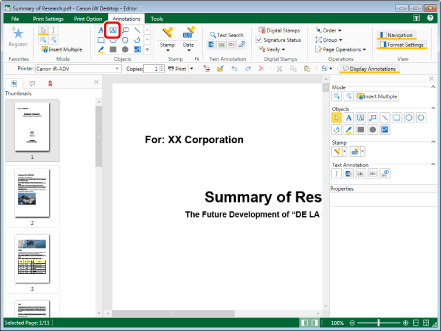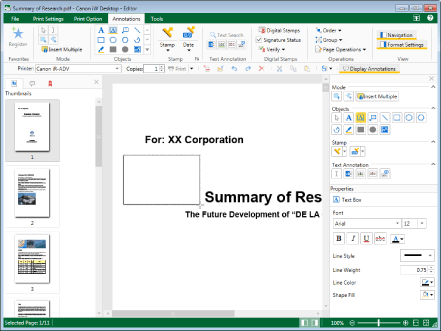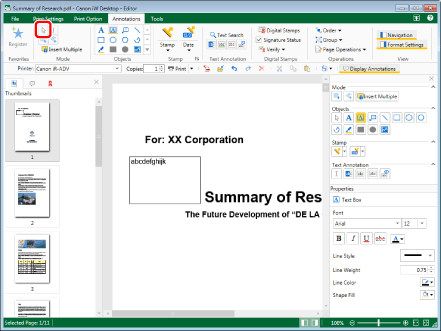Inserting Text Boxes
With Desktop Editor, you can insert a text box (framed text) into a document as an annotation.
|
NOTE
|
|
When [Line Style] of a text box (framed text) is specified as [No Line], only text strings (frameless text) can be inserted. Alternatively, [Text] can be used to insert only text strings (frameless text).
When inserting fixed text, use a text stamp.
|
Inserting New Text Boxes
This section describes how to insert a text box into a document as a new annotation.
1.
Click  (Text Box) on the ribbon.
(Text Box) on the ribbon.
 (Text Box) on the ribbon.
(Text Box) on the ribbon.Or, click  (Text Box) on the Details Window.
(Text Box) on the Details Window.

The properties of the text box are displayed on the Details Window.
|
NOTE
|
|
If the Details Window is not displayed, see the following.
This operation can also be performed with the tool buttons on the toolbar. If tool buttons are not displayed on the toolbar of Desktop Editor, see the following to display them.
When you want to insert text boxes multiple times, double-click
Perform one of the following operations to cancel the button selection.
Click the selected button on the Details Window again
Click another button on the Details Window
Click a command on the ribbon
Press the [Esc] key on the keyboard.
You can click
 (Insert Multiple) on the ribbon to insert multiple annotations. For more information, see the following. (Insert Multiple) on the ribbon to insert multiple annotations. For more information, see the following. |
2.
Configure the properties of the text box.

|
[Font]
|
Configure the font of text boxes.
|
|
[Font]
|
Select the font to use from the list displayed when you click
|
|
[Font Size]
|
Select the font size to use from the list displayed when you click
|
|
[Bold]
|
Makes the string bold.
|
|
[Italic]
|
Makes the string italic.
|
|
[Underline]
|
Underlines the string.
|
|
[Strikethrough]
|
Adds a strikethrough to the string.
|
|
[Font Color]
|
Select the font color you want to use from the list displayed when you click
|
|
[Line Style]
|
Select the line style you want to use from the list displayed when you click
|
|
[Line Weight]
|
Set the line thickness. You can specify a line thickness from 0.25 point to 12.00 point. You can specify a line thickness in units of 0.25 point by using
|
|
[Line Color]
|
Select the line color you want to use from the list displayed when you click
|
|
[Shape Fill]
|
Select the color you want to use to fill from the list displayed when you click
|
|
NOTE
|
|
If you select [More Colors] in [Font Color], [Line Color], or [Shape Fill], the [Color] dialog box is displayed and you can set a color that is not listed in [Font Color], [Line Color], or [Shape Fill].
You can also configure the properties of the annotation with the following commands.
 (Font) (Font) (Font Size) (Font Size) (Bold) (Bold) (Italic) (Italic) (Underline) (Underline) (Strikethrough) (Strikethrough) (Font Color) (Font Color) (Line Style) (Line Style) (Line Weight) (Line Weight) (Line Color) (Line Color) (Fill) (Fill)If commands are not displayed on the ribbon of Desktop Editor, see the following to display them.
This operation can also be performed with the tool buttons on the toolbar. If tool buttons are not displayed on the toolbar of Desktop Editor, see the following to display them.
|
3.
Move the mouse pointer to the Work Window.
The shape of the mouse pointer changes to  .
.
|
NOTE
|
|
To cancel the insertion process, do one of the following.
Click
 (Select Object) on the ribbon (Select Object) on the ribbonClick
 (Select Text) on the ribbon (Select Text) on the ribbonClick
 (Grab Mode) on the ribbon (Grab Mode) on the ribbonClick the command selected on the ribbon again
Click
Click
Click
Click the selected button on the Details Window again
Press the [Esc] key on the keyboard
|
4.
Drag the mouse pointer from the starting vertex to the ending vertex of the text box (frame).

|
NOTE
|
|
You can insert a square text box by dragging the mouse pointer while holding down the [Shift] key on the keyboard.
|
5.
Enter text.
6.
Click on the Work Window outside the text box you inserted to deselect the text box.
|
NOTE
|
|
To enter a line break, press the [Enter] key on the keyboard.
If the text string is too long to fit in the text box, a line break is automatically inserted.
If there are too many lines of text to fin in the text box, the text is scrolled within the text box, and the last line of the text is always displayed.
|
Changing Text Box Content
This section describes how to edit the content of a text box inserted into a document.
1.
Click  (Select Object) on the ribbon.
(Select Object) on the ribbon.
 (Select Object) on the ribbon.
(Select Object) on the ribbon.Or, follow one of the steps described below.
Click  (Select Text) on the ribbon
(Select Text) on the ribbon
 (Select Text) on the ribbon
(Select Text) on the ribbonClick  (Grab Mode) on the ribbon
(Grab Mode) on the ribbon
 (Grab Mode) on the ribbon
(Grab Mode) on the ribbonClick  (Select Object) on the Details Window
(Select Object) on the Details Window
Click  (Select Text) on the Details Window
(Select Text) on the Details Window
Click  (Grab Mode) on the Details Window
(Grab Mode) on the Details Window

|
NOTE
|
|
If the Details Window is not displayed, see the following.
This operation can also be performed with the tool buttons on the toolbar. If tool buttons are not displayed on the toolbar of Desktop Editor, see the following to display them.
|
2.
Click the text in the text box to change the content on the Work Window.
The shape of the mouse pointer changes to  .
.
3.
Change the text.
|
NOTE
|
|
To enter a line break, press the [Enter] key on the keyboard.
If the text string is too long to fit in the text box, a line break is automatically inserted.
If there are too many lines of text to fin in the text box, the text is scrolled within the text box, and the last line of the text is always displayed.
|
4.
Click on the Work Window outside the text box you edited to deselect the text box.
|
NOTE
|
|
For details on how to copy text box content, see the following.
|